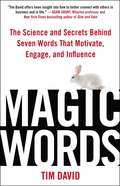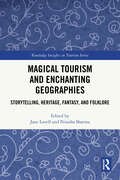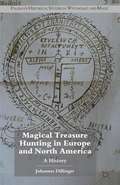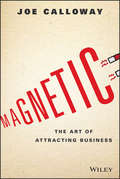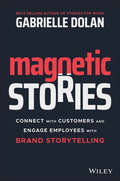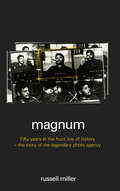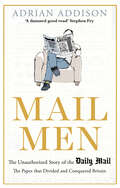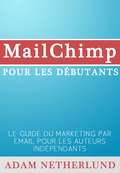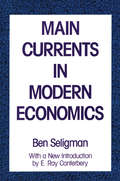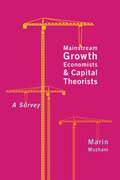- Table View
- List View
Magic Bus: From Childhood to Livelihood
by V. Kasturi Rangan Anjali Raina Rachna Chawla Vikram GandhiCase
Magic Words
by Jonah BergerA NEXT BIG IDEA CLUB 'MUST-READ'New York Times bestselling author Jonah Berger’s cutting-edge research reveals how six types of words can increase your impact in every area of life: from persuading others and building stronger relationships, to boosting creativity and motivating teams.Almost everything we do involves words. Words are how we persuade, communicate, and connect. They’re how leaders lead, salespeople sell, and parents parent. They’re how teachers teach, policymakers govern, and doctors explain. Even our private thoughts rely on language.But certain words are more impactful than others. They’re better at changing minds, engaging audiences, and driving action. What are these magic words, and how can we take advantage of their power?In Magic Words, internationally bestselling author Jonah Berger gives you an inside look at the new science of language and how you can use it. Technological advances in machine learning, computational linguistics, and natural language processing, combined with the digitization of everything from cover letters to conversations, have yielded unprecedented insights.Learn how salespeople convince clients, lawyers persuade juries, and storytellers captivate audiences; how teachers get kids to help and service representatives increase customer satisfaction; how startup founders secure funding, musicians make hits, and psychologists identified a Shakespearean manuscript without ever reading a play.This book is designed for anyone who wants to increase their impact. It provides a powerful toolkit and actionable techniques that can lead to extraordinary results. Whether you’re trying to persuade a client, motivate a team, or get a whole organization to see things differently, this book will show you how to leverage the power of magic words.
Magic Words
by Tim DavidYears of experience as a magician taught Tim David that real magic is all about words, and the way they influence the minds of the audience. What sets a professional magician apart from an amateur are people skills like communication, influence, and engagement--skills that are also effective in the workplace. By applying seven "magic" words in a business setting, David offers tools for effective and persuasive communication. You will learn: The secret word that Harvard psychologists discovered is the key to unlocking human motivation How one very special word (spoken only inside your mind) mysteriously has a profound positive impact on those around you The number one mistake that managers make during 1-on-1's, and the one simple word that can fix it all What Dale Carnegie dubs "the sweetest sound in any language" How one tiny word can instantly change someone's mind for the better The single word that an in-depth study of thousands of hours of call center recordings revealed as the quickest way to reduce differences and calm people down How the infamous "But Eraser" works and why so many people mess it up The REAL magic behind the word "thanks" The seven words: Magic Word #1 - Because Magic Word #2 - "Name" Magic Word #3 - If Magic Word #4 - But Magic Word #5 - Absolutely Magic Word #6 - Thanks Magic Word #7 - Help
Magic Words at Work: Powerful Phrases to Help You Conquer the Working World
by Howard Kaminsky Alexandra PenneyFrom the bestselling authors of Magic Words: a collection of workplace wisdom for spectacular results on the jobHaving survived and thrived in the competitive media industry, Alexandra Penney and Howard Kaminsky are now revealing their strategies for success. Magic Words at Work captures lessions learned in the trenches and coins perfect turns of phrase for every office situation, including:• Raising Your Voice Can Work Better Than Raising Your Hand: Don’t spend your life asking for permission and waiting to be called on• The Red Light Is On: Learn the secret to working without interruption • Make Like a Prairie Dog: When management is in flux, stay low to the ground• I'm Going to Lead Between the Lines: Find a solution, then make it fit the rules • Low Overhead Equals High Independence: Living debt-free keeps your options wide openWith a memorable mixture of chutzpah and charm, Kaminsky and Penney deliver the bottom line on rising to the top.
Magical Capitalism: Enchantment, Spells, and Occult Practices in Contemporary Economies
by Brian Moeran Timothy de Waal MalefytThis volume of essays examines the ways in which magical practices are found in different aspects of contemporary capitalist societies. From contract law to science, by way of finance, business, marketing, advertising, cultural production, and the political economy in general, each chapter argues that the kind of magic studied by anthropologists in less developed societies – shamanism, sorcery, enchantment, the occult – is not only alive and well, but flourishing in the midst of so-called ‘modernity’. Modern day magicians range from fashion designers and architects to Donald Trump and George Soros. Magical rites take place in the form of political summits, the transformation of products into brands through advertising campaigns, and the biannual fashion collections shown in New York, London, Milan and Paris. Magical language, in the form of magical spells, is used by everyone, from media to marketers and all others devoted to the art of ‘spin’.While magic may appear to be opposed to systems of rational economic thought, Moeran and Malefyt highlight the ways it may in fact be an accomplice to it.
Magical Tourism and Enchanting Geographies: Storytelling, Heritage, Fantasy, and Folklore (Routledge Insights in Tourism Series)
by Jane Lovell Nitasha SharmaThis book explores the events, attractions, and places that comprise magical tourism. It showcases magical storytelling, ecologies, realities, entities, belief systems, cultural heritage, and rituals leading to spiritual, otherworldly, enchanting, mindful, interconnected, green, and dark experiences.The volume offers the reader insights into the exciting, popular new tourism trend of magical tourism and its over-arching attributes and tropes. Chapters feature a number of case studies and discussions including the history of magical travel, studies of affect, witch festivals, the rights of mythical animals, folkloric beasts, unmappable places that seem to retreat and slide sideways, multi-layered place folklore and mythology, portals, nexuses of meaning, fayres, festivals, identities, and cos-play. This volume addresses the challenges of sustainable futures, green heritages, commercialisation, representation, inclusion, accessibility, community ownership, magical events, beliefs, and practices and asks if there is a magical turn in research.The book is highly relevant to those with expertise and interest in geography, tourism, hospitality and events studies, marketing, religious studies, anthropology, sociology, and heritage and cultural studies.
Magical Treasure Hunting in Europe and North America
by Johannes DillingerThe first comprehensive history of magical treasure hunting from the Middle Ages to the 20th century, revealing a magical universe of treasure spirits, and wizards who tried to deal with them. Combining history and anthropology, this study sees treasure hunting as an expression of shifting economic mentalities and changing ideas about history.
Magnetic
by Joe CallowayMagnetic: The Art of Attracting Business is a look at how consistently successful businesses are able to attract a steady and ever-increasing flow of customers. This innovative text examines a range of simple, powerful strategies that businesses of any size or type can use to attract new customers. The key is to do those things that harness the power of the single most important factor in buying decisions: positive word of mouth and referrals from happy existing customers. Magnetic businesses are intentional, strategic, and focused on creating positive experiences that become the stories their customers tell about them. Whether on the internet or face to face, it's what satisfied customers say about you that is the most powerful driver of growth for your business. Becoming Magnetic and attracting business, truly is an art, rather than a science, because every business is different, and uses a unique combination of strategy, people, and purpose to achieve success and growth. There is no one-size-fits-all formula, but with creativity and focus, any business can create a powerful revenue growth engine that continuously works to build and sustain success. Learn how to match successful growth strategies with your people, purpose, and culture to create your own unique 'magnetism' to attract business. Discover the simple, powerful keys to growth used by a range of market leading businesses, from a snowboard manufacturing startup company and a website design professional to a minor league baseball team and an family owned upscale grocery store. All of them utilize ideas that you can put to work immediately in your business to become Magnetic. Create a magnetic mindset in your people that leads not only to happier customers who refer others to you, but to more satisfied employees who help attract and recruit great new employees to keep your momentum going. Simplify and clarify how you think about your business to have your entire team become more focused, efficient, and effective in doing those few vitally important things that matters most in driving growth and sustaining success.
Magnetic Sponsoring
by Mike DillardMagnetic Sponsoring is unlike anything you've ever seen or read before when it comes to building a network marketing or MLM business.
Magnetic Stories: Connect with Customers and Engage Employees with Brand Storytelling
by Gabrielle DolanTake control of your brand and your stories for greater success Your brand is the stories people share about you when you're not in the room, and it's these brand stories that determine if people buy from you, employ you, work for you or invest in you. When the stakes are that high, wouldn't you want to take control of it? In Magnetic Stories, business storytelling expert Gabrielle Dolan reveals how you too can create and share stories that stick. Learn how to: define and distinguish your brand stand out from the competition implement brand storytelling effectively strengthen your presence online by sharing magnetic stories make your employees and customers your greatest advocates. In a world of inauthentic brands, Magnetic Stories is a must read for anyone who wants their brand to be relatable, believable and to create long-term brand loyalty.
Magnify Your Purpose: An Introvert's Guide to Creating a Coaching Business that Reflects Who You Are
by Stacey WecksteinDo what you love and you&’ll never work a day in your life—and with the help of this inspiring self-help guide, you can do just that! What&’s holding you back from doing what you love? Do you want to create a business that reflects who you are? And stop feeling guilty about what others think you &“should&” do with your life? In Magnify Your Purpose, creative business coach Stacey Weckstein, founder of Radiant Mind and Body LLC, will help you find your inner voice and the confidence to bring your authentic self out into the world. She will help you navigate around the pitfalls where too many creative professionals and new coaches get stuck trying to fit into traditional ways of doing business. Best of all, she will teach you―as she has taught herself and many others―how to turn your passions into a purposeful career. Join Stacey on the journey of reconnecting with yourself and manifesting your dreams.
Magnum: Fifty Years at the Front Line of History
by Russell MillerThis book is a biography of Magnum, told largely in the words of its photographers. It offers a unique perspective on half a century of world history from an extraordinary group of men and women who were front line witnesses at virtually every major event in the last fifty years. Wars, famines, natural disasters, social, political and environmental crises - Magnum photographers were there. They have been acute observers of the human condition, photographing the richest people in the world, the poorest, the least known and the most celebrated, from Marilyn Monroe to Che Guevara, JFK to Nelson Mandela, Picasso to Krushchev. This is a multi-layered story. At one level, it tells how a small group of photographrs - among them Robert Capa, Henri Cartier-Bresson and George Rodger - came together, established and nurtured a co-operative photographic agency that has survived against all the odds to become the most famous in the world. At a secondary level, it is the richly anecdotal story of the photographers themselves, their adventures around the world and their feelings about, and reactions to, their assignments.
Magnus Resch: Transforming the Art Market Through Transparency
by Sarah Mehta Henry W. McGeeEconomist and entrepreneur Magnus Resch was on a mission to make the art market more transparent. To that end, in 2014, he began building the Magnus app, which catalogued the price and transaction history of millions of works of art. Users could download the app, take a photo of any flat artwork, and the app would display that piece's price along with other pertinent information. Resch believed that such radical transparency would grow the small, rather insular, network of serious art collectors. By May 2018, the app had garnered strong user engagement, with over 10,000 new downloads per month. But Resch was not yet generating revenue from the Magnus app, which was free for users to download. The case explores Resch's options for monetizing the app, as well as the benefits and drawbacks of each option.
Magpie: Developing and Using Buyer Personas
by Frank V. CespedesThe founders of a start-up platform for publishers have developed preliminary personas of target customers, and are evaluating the implications for initial target buyers, messaging, and marketing programs.
Mahindra & Mahindra: Creating Scorpio
by Tarun Khanna Rajiv Lal Merlina ManocaranDetails the emergence of a private sector automobile manufacturer in India that has created globally competitive and cheap versions of an SUV commonly available worldwide. Asks us to think about the parent corporation's next steps in leveraging this success. In particular: To what extent does it make sense to expand overseas vs. entrenching itself within the home market--India?
Mahindra & Mahindra: Leveraging India's Size for Global Scale in Tractors--A Profile of One of India's Pioneering Multinationals
by Nirmalya Kumar Pradipta K. Mohapatra Suj ChandrasekharMahindra & Mahindra started in 1945 at the dawn of Indian independence and has since transformed from a steel trader, to an assembler of Jeeps from kits imported from the U.S., to a multifaceted business with a global presence in eight key sectors and global revenue in 2008 of $6.7 billion. This chapter focuses on M&M's two largest businesses--automotive and farm equipment, tracing the company's sometimes rocky journey to becoming a global powerhouse. This chapter is excerpted from "India's Global Powerhouses: How They Are Taking on the World."
Mahindra Lifespace Developers' Venture into Affordable Housing
by Joseph Fuller Vidhya MuthuramCase
Maid to Order in Hong Kong: Stories of Migrant Workers, Second Edition
by Nicole ConstableMiddle-class Chinese women in the global city of Hong Kong have entered the workforce in unprecedented numbers over the past three decades, and the demand for foreign domestic workers has soared. A decade ago some foretold the decline in foreign workers and the influx of mainland workers. But today over 120,000 women from the Philippines, over 90,000 from Indonesia, and thousands more from other parts of South and Southeast Asia serve as maids on two-year contracts in Hong Kong, sending much needed remittances to their families abroad. Nicole Constable tells their story by updating Maid to Order in Hong Kong with a focus on the major changes that have taken place since Hong Kong's reunification with mainland China in 1997, the Asian financial crisis of the late 1990s, and the outbreak of SARS in 2002-2003. Interweaving her analysis with the women's individual stories, she shows how power is expressed in the day-to-day lives of Filipina domestic workers and more-recent Indonesian arrivals.
Mail Men: The Unauthorized Story of the Daily Mail
by Adrian AddisonDiscover the secret history of the paper that has shaped Britain and taken over the world. Perhaps because of the power and fear that the Daily Mail commands, this is the first book to provide an unauthorized account of the newspaper with more global readers than any other. With a gripping personality-led narrative, informed by sources near the top of the paper, Mail Men investigates the secret behind the Mail's extraordinary longevity and commercial success. But, it also examines the controversies that have beset the paper—from its owner's flirtation with fascism in the 1930s to its fractious relationship with liberals, celebrities and politicians today. Asking why the Mail attracts such anger around the world, Addison explores how insiders view the furore the paper creates both in its print and online incarnation. He also uses his numerous contacts to ask how the paper has stayed relevant for over a century. How has MailOnline built such a huge global audience by focussing on celebrity gossip, in apparent tension with the sometimes puritanical values of its sister print edition? Gripping and revealing, this book gives a previously unseen insight into the colorful cast of senior MailMen (yes, nearly all men) who have molded the paper through the decades—from Alfred C. Harmsworth, the Mail's founder and first owner, a frenetic genius who invented the popular press as we know it, to Martin Clarke, the fearsome Scot who runs MailOnline, the most popular newspaper website in the world.
Mailchimp Pour Les Débutants: Le Guide Du Marketing Par Email Pour Les Auteurs Indépendants
by Leslie Pierobon Adam NetherlundEn tant qu'auteur indépendant, vous avez peut-être entendu parler des newsletters et songé à en créer une. Mais comment s'y prendre ? De nos jours, il existe énormément de possibilités -- AWeber, Constant Contact, iContact, Vertical Response et tant d'autres -- mais l'une des plus populaires est MailChimp.Si vous avez déjà pensé à essayer MailChimp mais ne saviez pas vraiment par où commencer, ce livre est pour vous. Suivez de simples instructions étape par étape qui vont vous aider à facilement envoyer votre première campagne et à entrer en contact avec vos fans.Dans ce court guide conçu pour ceux qui débutent avec MailChimp, vous découvrirez :- comment créer un compte ainsi que votre première liste ;- comment créer différents types de formulaires d'inscription ;- comment créer votre première campagne ;- comment analyser les statistiques ;- des idées pour créer votre mailing list (spécifiques à l'auto-édition) ;- des conseils généraux et les choses à faire/ne pas faire lors de la création de vos campagnes ;- les possibilités offertes par les plugins Wordpress, les applications mobiles, les formulaires pour tablettes et pour Facebook.Le marketing par e-mail n'est ni difficile ni onéreux, alors détendez-vous et commençons à vous ouvrir à de nouvelles compétences.
Main Currents in Modern Economics: Economic Thought Since 1870
by Ben B. SeligmanMain Currents in Modem Economics deserves to be the classic it is. At the time of its original publication in 1962, Ben Seligman, a scholar’s scholar, had immersed himself in the development of economic thought since 1870. This product of his efforts is truly timeless. Why is Main Currents still modern and surprisingly up-to-date? For Seligman, the story begins with the revolt of German historical writers against the rigidity of classical doctrine, a natural starting point for contemporary theory. He takes us from the world of Thorstein Veblen to Galbraith’s theory of countervailing power and the affluent society—worlds that he makes us understand are not so far apart., Seligman also shows us how the doctrines begin to repeat themselves. Tradition is reaffirmed with the rediscovery of marginalism by Jevons, the Austrians, and J. B. Clark. A more neutral version of “equilibrium economics” is supplied by Leon Walras and Vilfredo Pareto, a main current of thought extended by John R. Hicks and Paul A. Samuelson. Seligman characterizes the principal trait of modern doctrine as the use of technique for its own sake. Dismissing G.L.S. Shackle’s writing on uncertainty, he criticizes Shackle’s use of continuous rather than discontinuous function., Main Currents may have been published too soon to be fully appreciated. Selig-man’s focus on the thrust toward technique now has a ring of truth that can no longer be ignored. As Ray Canterbery notes in his introduction, in some respects only the names of the players have changed, and Main Currents’ pertinence to today’s issues is self-evident. Economics has moved so deeply into technique that the next generation may have to rediscover the past in order to find its way out. Seligman s book is a good place to begin the journey.
Main Street Millionaire: How to Make Extraordinary Wealth Buying Ordinary Businesses
by Codie SanchezRich people know a secret. In this book, former Wall Street investor Codie Sanchez pulls back the curtain.Most people look for wealth in all the wrong places. From dropshipping and startups to grinding for promotions, you might believe you have to trade your life to be one of the few who win. But the truly rich know these paths are paved with delusion and false promises.In Main Street Millionaire, Codie Sanchez teaches you the path the wealthy really walk. Instead of risking it all with little chance of success, she shows you how to acquire cash-flowing businesses that are winning right now. Sanchez, one of the world&’s leading small business experts, reveals the dealmaking framework she&’s taught to tens of thousands, and that she&’s used to build her own 9-figure holding company. Her secret? She acquires overlooked &“Main Street&” businesses. We&’re talking about the unsexy but reliably profitable industries — like plumbing, construction, cleaning, electrical — that white collar workers have overlooked.In this book, you&’ll see practical strategies and step by step processes to acquire cash flow and freedom. You&’ll meet humans just like you who have changed their life through ownership. You will learn: Why today&’s market is ripe for generational wealth creation How to identify and close amazing business deals, without being wealthyHow to 10x your growth after acquiring a small businessThe 7 businesses you should never buy, and whyHow to own multiple businesses at once (without losing your mind)Main Street Millionaire will reshape the way you think about your wealth and ownership forever. However, it&’s not for slackers. It&’s for those who want meaning and fulfillment while building their community. Codie's no-BS, out-of-the-box wisdom is the antidote to a complacent life of making other people rich. In summary: Your money, and meaning, is on Main Street.
Maine in World War I (Images of America)
by Earle G. Shettleworth Jr. Jason C. LibbyWith the same patriotic fervor as Maine�s response to a call for troops in the Civil War, more than 35,000 men and women across the state joined the armed forces in 1917�1918 to fight in aid of America�s European allies against Germany, as well as to redress German destruction of American vessels in the North Atlantic. Mainers also provided vital support to the United States and the Allies through war-related industries, like shipbuilding, munitions, textiles, and agriculture, while purchasing more than $100 million in war bonds and donating bandages, books, and other comforts of home to the troops. The war may have been �over there,� but its effects were found throughout the state of Maine.
Mainstream Growth Economists and Capital Theorists
by Marin MuzhaniMainstream Growth Economists and Capital Theorists provides a historical survey and ideal introduction to modern economics, arguing that due to significant changes in recent years, a re-evaluation is in order. Marin Muzhani presents an informed study of the debates regarding economic growth and development that began in the 1930s in response to the Great Depression. He argues that in the wake of that crisis, the challenge for economists was to understand how to generate stable economic growth in order to prevent future crises. The theories of John Maynard Keynes, in particular, sought to explain the reasons for unemployment and recessions, paving the way for the field of macroeconomics and challenging the basic premises of neoclassical economics. In the late 1930s and 1940s, economists began to extend Keynes' ideas, synthesizing them with neoclassical ideas in order to explain economic growth. This "neoclassical synthesis" would dominate mainstream macroeconomic thought for the next forty years until the mid-1980s with the introduction of endogenous growth theories. Taking into account the historical background, the multitude of interpretations of modern growth models, and the geography of mainstream economists, Mainstream Growth Economists and Capital Theorists will simplify the structure of growth theory for the next generation of economists.
Mainstream Growth Economists and Capital Theorists: A Survey
by Marin MuzhaniA necessary assessment of modern growth theories within a historical context.


